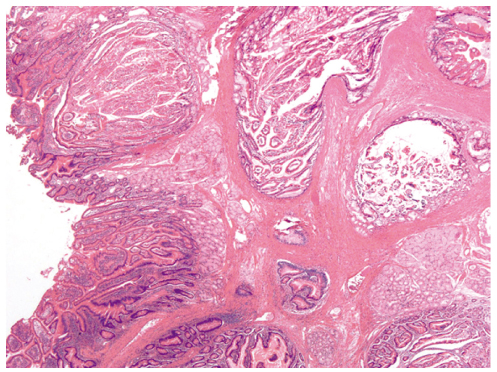Korean J Obstet Gynecol.
2011 Feb;54(2):115-118. 10.5468/KJOG.2011.54.2.115.
A case of Peutz-Jeghers syndrome with endometrial adenomyomatous polyp
- Affiliations
-
- 1Department of Obstetrics and Gynecology, Kyungpook National University Hospital, Kyungpook National University School of Medicine, Daegu, Korea. chssa0220@hanmail.net
- KMID: 2037502
- DOI: http://doi.org/10.5468/KJOG.2011.54.2.115
Abstract
- Peutz-Jeghers syndrome, which has autosomal dominant inheritance, shows pigmentation in lip and skin. It also has features of harmatomatous polyp over the gastrointestinal tract, while sometimes developing tumor in genital tract. Known tumors in female genital tract include cervical adenocarcinoma, sex cord tumor, etc. Adenomyomatous polyp in uterus is also one of the rare diseases, which seldom develop in the absence of hormone treatment such as Tamoxifen. Currently, there is one case of Peutz-Jeghers syndrome patient with endometrial adenomyomatous polyp. Authors found mole-like lesions on the transvaginal ultrasonogram in a typical Peutz-Jeghers syndrome patient without pregnancy history and previous chemotherapy. After confirming its diagnosis of adenomyomatous polyp on resectoscopic biopsy, we report our fihndings along with brief literature review.
MeSH Terms
Figure
Reference
-
1. Chen KT. Female genital tract tumors in Peutz-Jeghers syndrome. Hum Pathol. 1986. 17:858–861.2. Giardiello FM, Brensinger JD, Tersmette AC, Goodman SN, Petersen GM, Booker SV, et al. Very high risk of cancer in familial Peutz-Jeghers syndrome. Gastroenterology. 2000. 119:1447–1453.3. Sato H, Nanjo H, Tanaka H, Tanaka T. Arias-Stella reaction in an adenomyomatous polyp of the uterus. Acta Obstet Gynecol Scand. 2007. 86:106–108.4. Peterson WF, Novak ER. Endometrial polyps. Obstet Gynecol. 1956. 8:40–49.5. Nasu K, Sugano T, Miyakawa I. Adenomyomatous polyp of the uterus. Int J Gynaecol Obstet. 1995. 48:319–321.6. Takeuchi M, Matsuzaki K, Uehara H, Shimazu H, Nishitani H. A case of adenomyomatous polyp of the uterus associated with tamoxifen therapy. Radiat Med. 2005. 23:432–434.7. De Brux J. Histopathologie gyntcologique. 1971. Paris: Masson.8. Silverberg SG, Kurman RJ, editors. Atlas of tumor pathology. 1992. 3rd ed. Washington, DC: Armed Forces Institute of Pathology.9. Furuhashi M, Miyabe Y, Oda H. Adenomyomatous polyp mimicking hydatidiform mole on ultrasonography. Arch Gynecol Obstet. 2000. 263:198–200.10. Firminger HI. Atlas of tumor pathology. 1968. Washington, DC: Armed Forces Institute of Pathology.
- Full Text Links
- Actions
-
Cited
- CITED
-
- Close
- Share
- Similar articles
-
- A Case of Hamartomatous Polyp without Peutz-Jeghers Syndrome Arising from Appendix
- Two Cases of a Solitary Peutz-Jeghers Polyp in the Rectum
- Solitary Peutz-Jeghers type harmartomatous polyp in duodenum with gastric foveolar epithelium: a case report
- A Case of a Solitary Peutz-Jeghers Type Hamartomatous Polyp in the Duodenum with Upper Gastrointestinal Bleeding as the Initial Diagnosis
- Peutz-Jeghers Syndrome with Recurrent Intussusception



